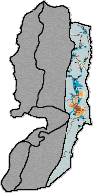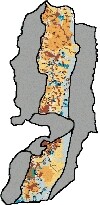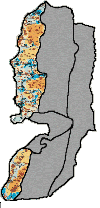25 January 2002
“Israel’s supposed ‘offer’ to withdraw from 95% of the Westbank will create not peace but rather a Palestinian prison state. The issue is one of control, viability, and sovereignty - not just territory.”
“Just as prison guards ‘control’ only 5% of a prison (the outer walls, cells, and corridors), so too will Israeli border crossings, settlements, and bypass roads continue to control a Palestinian mini-state. The only solution: dismantle the Matrix of Control completely.”
- Jeff Halper, Israeli Committee against House Demolitions
“The international community does not recognize Israel’s sovereignty over any part of the occupied territories.”
- US State Department, Report on Human Rights Practices, FEB/01
All borders controlled by Israel
Palestinian areas disconnected
Natural resources stripped
East Jerusalem encircled by Israel
Gaza becomes ‘world’s largest prison’
“You know, it’s not by accident that the settlements are located where they are…Come what may, we have to hold the western security area, which is adjacent to the Green Line, and the eastern security area along the Jordan River and the roads linking the two. And Jerusalem, of course. And the hill acquifer.”
- Ariel Sharon, Prime Minister of Israel, quoted in the Israeli newspaper Ha’aretz, 12 April 2001
Israel’s Occupation places 3 million Palestinians under Siege
Settler population doubled since ‘Oslo peace process’ began (1993)
Palestinians confined to enclaves
250 miles of Israeli bypass highways
Palestinian land expropriated and agriculture destroyed
‘Closure’ imposed on occupied territories
‘Greater Jerusalem’ Expansion Plan
“These restrictions severely impair not only the right of freedom of movement, but also other human rights [including] the right to work and make a living, the right to proper medical treatment, the right to education, and the right to maintain family life. These restrictions…are one of the primary reasons for the increased distress and despair in the Occupied Territories.”
- Israeli human rights group B’Tselem, May 2001
“Resettlement of the Israeli civilian population in occupied territories, including East Jerusalem, is illegal under the Fourth Geneva Convention.”
- US Ambassador William Scranton, New York Times, 25 march 1976
Analysis of B’tselem Map of the West Bank




Almost two million dunam of land seized by Israel over the years, mainly by means of its declaration as “state land,” have been included within the areas of jurisdiction of six regional councils, but not attached to any particular settlement. Some of these areas, particularly in the Jordan Valley, are farmed by settlers or used by the IDF as training zones. The vast majority of this land, however, is empty, constituting reserves for the future expansion of the settlements and the establishment of new industrial and tourism zones.